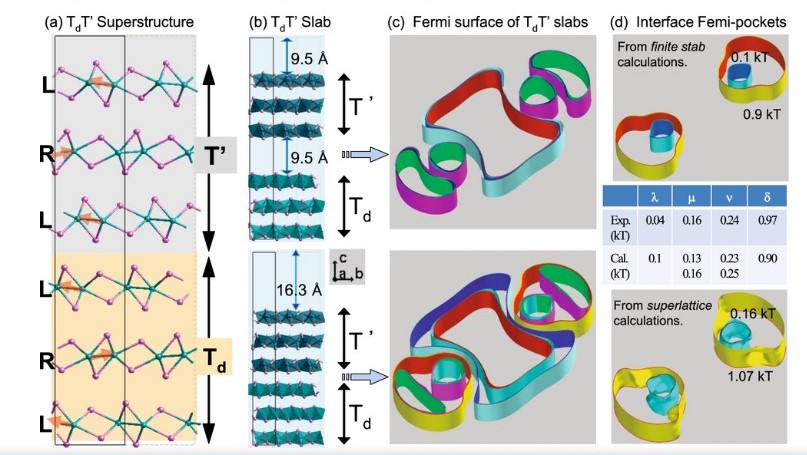A collaboration between the Quantum Materials Center (QMC) and the NIST Center for Neutron Research, led by QMC graduate student I-Lin Liu, has just published results reporting the discovery of a new topolo a Six layers of Td–T' periodic superstructure, consisting of three layers of Td and T' phases with L–L interface. b Three layers of Td and T' slabs, separated (top) and joined (bottom). c Fermi surface obtained from separated (top) and joined slabs (bottom). d—top: The difference in the Fermi surfaces of the separated (c—top) and joined slabs (c—bottom), directly indicating the states due to the Td–T' interface. Similarly, (d—bottom) shows the interface Fermi pockets from the periodic superstructure shown in (a). The middle panel in (d) shows the quantum oscillations from the Td–T' joint slab calculations (b—bottom) compared with the experimental frequencies, which are represented as Gaussian curves with equal but arbitrary intensities.gical phase in the layered transition metal chalcogenide MoTe2, a promising host of electronic Weyl nodes and topological superconductivity.
a Six layers of Td–T' periodic superstructure, consisting of three layers of Td and T' phases with L–L interface. b Three layers of Td and T' slabs, separated (top) and joined (bottom). c Fermi surface obtained from separated (top) and joined slabs (bottom). d—top: The difference in the Fermi surfaces of the separated (c—top) and joined slabs (c—bottom), directly indicating the states due to the Td–T' interface. Similarly, (d—bottom) shows the interface Fermi pockets from the periodic superstructure shown in (a). The middle panel in (d) shows the quantum oscillations from the Td–T' joint slab calculations (b—bottom) compared with the experimental frequencies, which are represented as Gaussian curves with equal but arbitrary intensities.gical phase in the layered transition metal chalcogenide MoTe2, a promising host of electronic Weyl nodes and topological superconductivity.
MoTe2 harbors both noncentrosymmetric Td and centrosymmetric T’ structural phases, both of which have been identified as topologically nontrivial. However, Liu and colleagues demonstrated via quantum oscillations and neutron scattering measurements, and first-principles calculations, how applied pressure drives MoTe2 between the Td and T’ phases, through an intermediate mixed-phase region. The mixed-phase region gives rise to a network of topological interface states that yield quantum oscillations that survive despite the strong structural disorder, opening the possibility of stabilizing multiple topological phases coexisting with superconductivity.
This work is published in npj Quantum Materials.